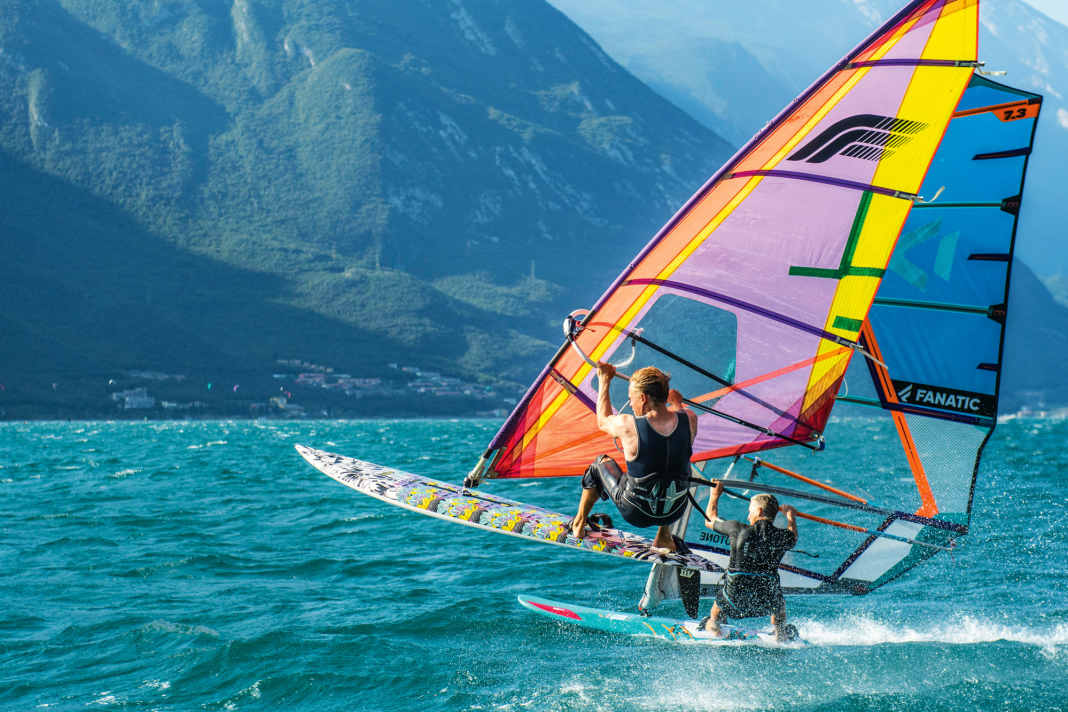





The roots of Fanatic lie far away from any surfable waters - in Selters in the deepest Westerwald. Heating oil tanks and containers have been manufactured in the Schütz factories since the 1950s. However, company founder Udo Schütz was also a passionate and successful racing driver and sailor. He built the sailing yacht "Container", with which he won the legendary Admiral's Cup. In 1981, when windsurfing was just beginning to become the absolute trend sport, he founded a board brand and in 1982 the "Eagle Wing - made by Fanatics" was the first animal to take off from the Westerwald. Since then, the company has had a chequered history with many sales and upheavals. Nevertheless, it is still one of the most successful windsurfing brands today and has remained true to itself, at least in part - the animal names still characterise the current model range today.
South African-born Craig Gertenbach has been part of the shelter since 1995, first as a tester, then in development, and since 2004 he has been in charge of Fanatic's fortunes as Brand Manager within the Boards and More Company in Oberhaching near Munich.
For surf, the 51-year-old takes a personal look back at the company's roots, the personalities who have shaped it and the many changes that have taken place over the last four decades.
Technology - The roots of Fanatic
Fanatic was initially a very "German" company that focussed heavily on technology. They built their own moulds and used a lot of high-tech materials right from the start. Thanks to its connections in the plastics industry, Schütz was able to use honeycomb early on. Production was highly automated - the materials were placed in the mould at the front and the almost finished board came out at the back. Very little manual labour was needed to finish the edges.
The moulds were extremely expensive at the time and so production was designed for high volumes. But the brand's philosophy was to have a unique selling point through high-tech production. I myself remember that the first Fanatic boards always had a colourful, sometimes risky and rapidly changing design compared to other brands, which were very focused on a high recognition value. I think we have maintained this throughout our 40-year history to this day.
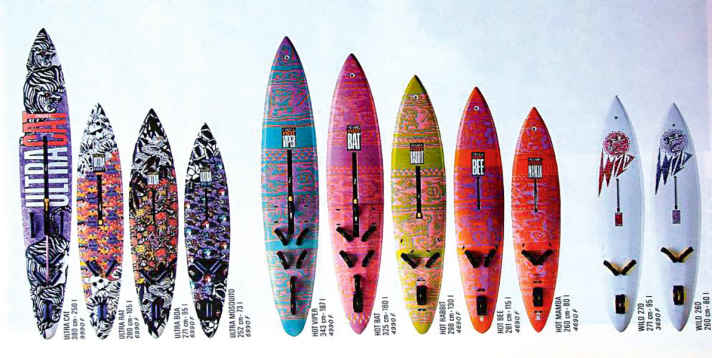
Even later, technology was always at the forefront at Fanatic. We were one of the first companies to venture into production at Cobra in Thailand, had engineers there and used CAD systems in the design process. And the decals were always emotional. I think every older surfer remembers the first Mosquito design. I still have a board like that in my office and I think it still looks great. That's why we've brought back design elements and names for the anniversary collection.
My first contact with Fanatic
My first Fanatic board was a Racy Cat. It was my first piece of racing equipment and it was the board that everyone rode at the time, I was impressed by its weight and technology - and of course the design. I later worked at F2 and tested with shaper Werner Gnigler. I learnt everything about testing from him back then. He was always given boards from other brands to compare and the Fanatic boards were far superior to the others in terms of weight, technology and looks. That was overwhelming for me and I will always remember it.
Another moment that really impressed me was when Cesare Cantagalli came to South Africa for the World Cup right after the 1986 Aloha Classic and landed his insane cheese rolls perfectly. He had the Mosquito with the incredible design. My friends and I, we were just about 16 years old and had seen it live on TV, went out in Langebaan and tried it even with completely inappropriate material. Cesare's performance had a lasting impact on Fanatic's image. In the 80s it was Philip Pudenz or Marco Campello, later came guys like Fabien Pendle, Torkil Kristensen and Nik Baker, but Cantagalli shaped the wave image for Fanatic. On his "Globotour" he travelled to exotic places all over the world and brought back breathtaking photos. Long before the GoPro age, he delivered mastmount photos and managed to transform Fanatic's technical, German image into a cool wave image. He was and still is a stylish character and his time at Fanatic was a game changer for the brand.
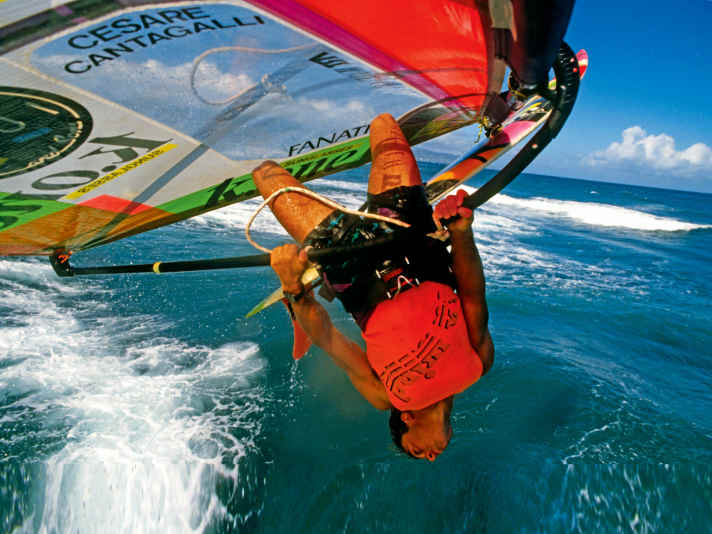
Another strong character in the team at this time was Maui Meyer, even though he only rode in the World Cup for a few years. Nik Baker then made a big impression in the 1990s. The Brit was one of the first to really work professionally and take windsurfing seriously in terms of equipment and training. With Sega, Red Bull and Oxbow, he had major sponsors outside of windsurfing and was one of Björn's biggest competitors at the time. Although he was smaller and lighter than Dunkerbeck, he also won many indoor events.
With surfers and kiteboards, Fanatic became the "Boarders Company"
In the mid-90s, Fanatic took a new direction. They called themselves the "Boarders Company" and produced wakeboards, wave riders and kiteboards. The windsurfing World Cup team was massively reduced, but Nik Baker was kept on the team as a kind of waterman. He was one of the key figures for Fanatic from 1994 until the end of the millennium.
Sebastian Wenzel joined Fanatic as a young lad in 1994 and was the exclusive shaper for the brand from 1997. Ralf Bachschuster, who was also one of the leading figures in the team in the 90s, once said that they spent an incredible amount of money on custom-made boards back then. They simply ordered their boards from their favourite shaper, stuck a few Fanatic stickers on them, but were practically not involved in the development of the production boards. Fanatic then tried to involve the riders a little more. When I joined the company in 1995, the management had the idea of employing three shapers, we would then test their boards and decide which were the best. So there was something like an internal competition.
World Championship title on series boards
However, this policy only lasted for about a year and a half. After that, the decision was made to employ Sebastian as the sole shaper. It was also decided that instead of sending the riders money for boards and stickers, they would be 100 per cent involved in the development. From then on, the riders were only allowed to use Sebastian's boards. This has been our business model for 23 years now - apart from a brief period when Francisco Goya was also allowed to use boards from Keith Teboul. However, he won his world champion title in the wave on a board from Sebastian.
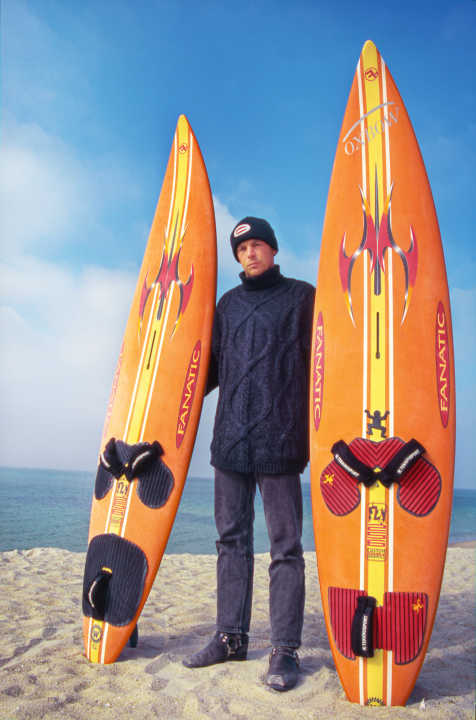
Riders and shapers working closely together is the key to success. If you pay someone to promote your product, then they should be fully behind it. This also makes the marketing much more authentic. I pushed this policy further when I became Brand Manager in 2004. In the past this has cost us some potential team riders who wanted to continue to have their boards built by other shapers, but I think it's a waste of resources to just let them do their thing. That's how Sebastian got better and better as a developer and the riders can give very helpful feedback if you channel it properly.
The way to Boards & More
Fanatic was sold to the Mistral Group at the end of 1999. F2, Fanatic, Mistral, the sail brands Arrows, ART and North Sails as well as snowboards and accessories were then under one roof. In 2000, Boards & More was created through a merger of F2, Mistral and Fanatic. There were also changes in marketing, away from a Waterman that represented all sports. With Rush Randle, who got a pro model with a skull on the bow, and Francisco Goya with his pro model with the sun design, Fanatic reclaimed its wave image.
Even though he left the company, Francisco Goya promoted the brand very strongly with his creativity. But he wanted to do his own thing, which was understandable because he was ready for the next step. He brought us the PWA title in the wave on one of Sebastian's boards, which helped him immensely in his development as a shaper. Cisco also helped us get new young team riders before he left the brand.
Young talent with World Cup potential
One of them was Victor Fernandez. I met him in a board camp in Pozo to sign a contract and realised that he didn't understand 90 per cent of what I was saying because he only spoke Spanish. Other young riders followed, such as Jonas Ceballos, Gollito Estredo, Cheo Diaz, but also Klaas Voget and Andre Paskowski. In the early 2000s, we focussed on talented young riders with the potential to win titles and less on the old guard. This is how the brand slogans "Young and wild" and "Addicted to ride" came about. It is very satisfying to see that this strategy has been successful. Gollito has become an icon with his nine freestyle titles. What he has achieved is insane. And Victor, with his three wave titles and countless podium finishes, has been a guarantee of success for years.
These guys, together with Klaas Voget and later Pierre Mortefon, have made the brand what it is today. The sport has changed since the days of Nik Baker, when the riders rode three disciplines with mountains of equipment. Today they are all more or less specialists. That's why we're happy to have Marc Paré, a potential wave world champion, on the team for the next five to ten years. I am convinced that it is good to integrate riders into the brand in the long term so that they become part of the family.
Experience and continuity
Our internal team is also characterised by experience and continuity. Sebastian has been with the company since 1994. I joined Fanatic in 1995, having previously worked for F2 and NeilPryde, initially as a rider, tester and developer. In 2000 I moved to the office and moved to Germany. I worked in all areas of the company before becoming Brand Manager in 2004. My wife Karin is responsible for international marketing and has been with the company since 2000. Before that, she had already been with NeilPryde for eight years. Klaas Voget now works with her in marketing and on waveboard development and has been with Fanatic since 1999. Daniel Aeberli has been Product Manager at Fanatic for seven years, having previously worked at F2.
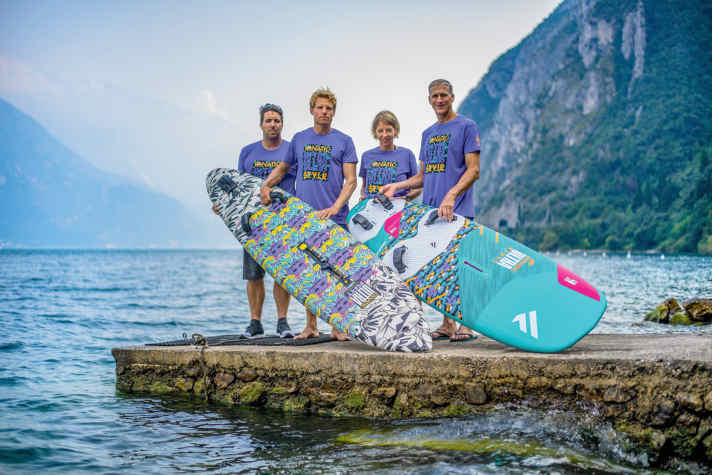
So we've all known each other for a long time and have a lot of experience. It's already going very well. In terms of personality, Sebastian and I don't always have to be the centre of attention. And we also appreciate it when our team riders work with us professionally over a longer period of time, live the sport and let the action on the water speak louder than words on land.
Is Fanatic conservative?
In an interview with you, you once asked me whether Fanatic isn't a bit conservative when it comes to new trends. That may even be true to a certain extent. We don't jump on every hype straight away, but also look at the market first. We are a German company and Germany is the largest windsurfing market. We are therefore close to the trends and can then act in a very market-orientated way. On the other hand, we were absolute pioneers in the area of CAD shaped boards, for example, which also brought us a lot of criticism at the time. "They no longer shape their boards by hand," was said at the time when we changed the familiar work steps with the computer milling machine. But in the end, this gave us a five to ten-year head start until the other companies caught up.
Continuity and not simply jumping on every bandwagon and believing in our products has always been our credo. Sometimes it takes a year or two, sometimes three or five for things that many people were initially negative about. Take the "stubby" boards, for example. Some people immediately claimed that it was their idea and others immediately wrote it off. For us, it was an absolute success. The Blast has been in the programme for five years and we haven't been able to improve it in that time, even with many new prototypes. This shows us that we did something right from the start. We are a small team and involve the team riders as much as we can, but it is also important for us not to just sit at a desk. It's also nice to be out on the water, trying things out and staying motivated for the work.
New trends keep the brand fresh
In recent years, we have also become involved in many other sports. Stand-up paddling, surfing and wing-foiling help us to get out of the windsurfing bubble a bit and get a bigger picture, even though the workload has increased. It also makes you a bit more relaxed. You get to meet other people, different types of media and attend other events. You find new approaches and don't get stuck in a one-way street. There are also synergies in many areas, so we can spread the costs for employees and agencies over two or three budgets. I find it very refreshing to be active in different sports.
I started windsurfing in 1982 and after 38 years you definitely don't get any better, you try to maintain your level as much as possible. So I really enjoy learning something new. The whole wing-foiling and windsurf-foiling thing is a bit reminiscent of the old days - everyone is keen to just go out and try something new. The more people there are on the water, whether with wings, SUP or even kiteboards, the greater the chance that they'll realise what a fantastic sport windsurfing is.

